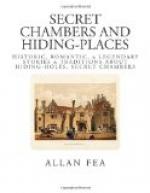The famous secret passage of Nottingham Castle, by which the young King Edward III. and his loyal associates gained access to the fortress and captured the murderous regent and usurper Mortimer, Earl of March, is known to this day as “Mortimer’s Hole.” It runs up through the perpendicular rock upon which the castle stands, on the south-east side from a place called Brewhouse yard, and has an exit in what was originally the courtyard of the building. The Earl was seized in the midst of his adherents and retainers on the night of October 19th, 1330, and after a skirmish, notwithstanding the prayers and entreaties of his paramour Queen Isabella, he was bound and carried away through the passage in the rock, and shortly afterwards met his well-deserved death on the gallows at Smithfield.
But what ancient castle, monastery, or hall has not its traditional subterranean passage? Certainly the majority are mythical; still, there are some well authenticated. Burnham Abbey, Buckinghamshire, for example, or Tenterden Hall, Hendon, had passages which have been traced for over fifty yards; and one at Vale Royal, Nottinghamshire, has been explored for nearly a mile. In the older portions in both of the great wards of Windsor Castle arched passages thread their way below the basement, through the chalk, and penetrate to some depth below the site of the castle ditch at the base of the walls.[1] In the neighbourhood of Ripon subterranean passages have been found from time to time—tunnels of finely moulded masonry supposed to have been connected at one time with Fountains Abbey.
[Footnote 1: See Marquis of Lorne’s (Duke of Argyll) Governor’s Guide to Windsor.]
A passage running from Arundel Castle in the direction of Amberley has also been traced for some considerable distance, and a man and a dog have been lost in following its windings, so the entrance is now stopped up. About three years ago a long underground way was discovered at Margate, reaching from the vicinity of Trinity Church to the smugglers’ caves in the cliffs; also at Port Leven, near Helston, a long subterranean tunnel was discovered leading to the coast, no doubt very useful in the good old smuggling days. At Sunbury Park, Middlesex, was found a long vaulted passage some five feet high and running a long way under the grounds. Numerous other examples could be stated, among them at St. Radigund’s Abbey, near Dover; Liddington Manor House, Wilts; the Bury, Rickmansworth; “Sir Harry Vane’s House,” Hampstead, etc., etc.
CHAPTER XIV
MINIATURE HIDING-HOLES FOR VALUABLES, ETC.




